Crispy, golden, and lightly dusted with powdered sugar, chiacchiere are a quintessential Italian treat enjoyed during Carnival season.
These delicate fried cookies, also known by other regional names such as frappe, cenci, or bugie, are deeply rooted in Italian culinary tradition.
Their name, chiacchiere, literally translates to “chatter” or “gossip,” likely referencing the cheerful and lively atmosphere of Carnival celebrations.
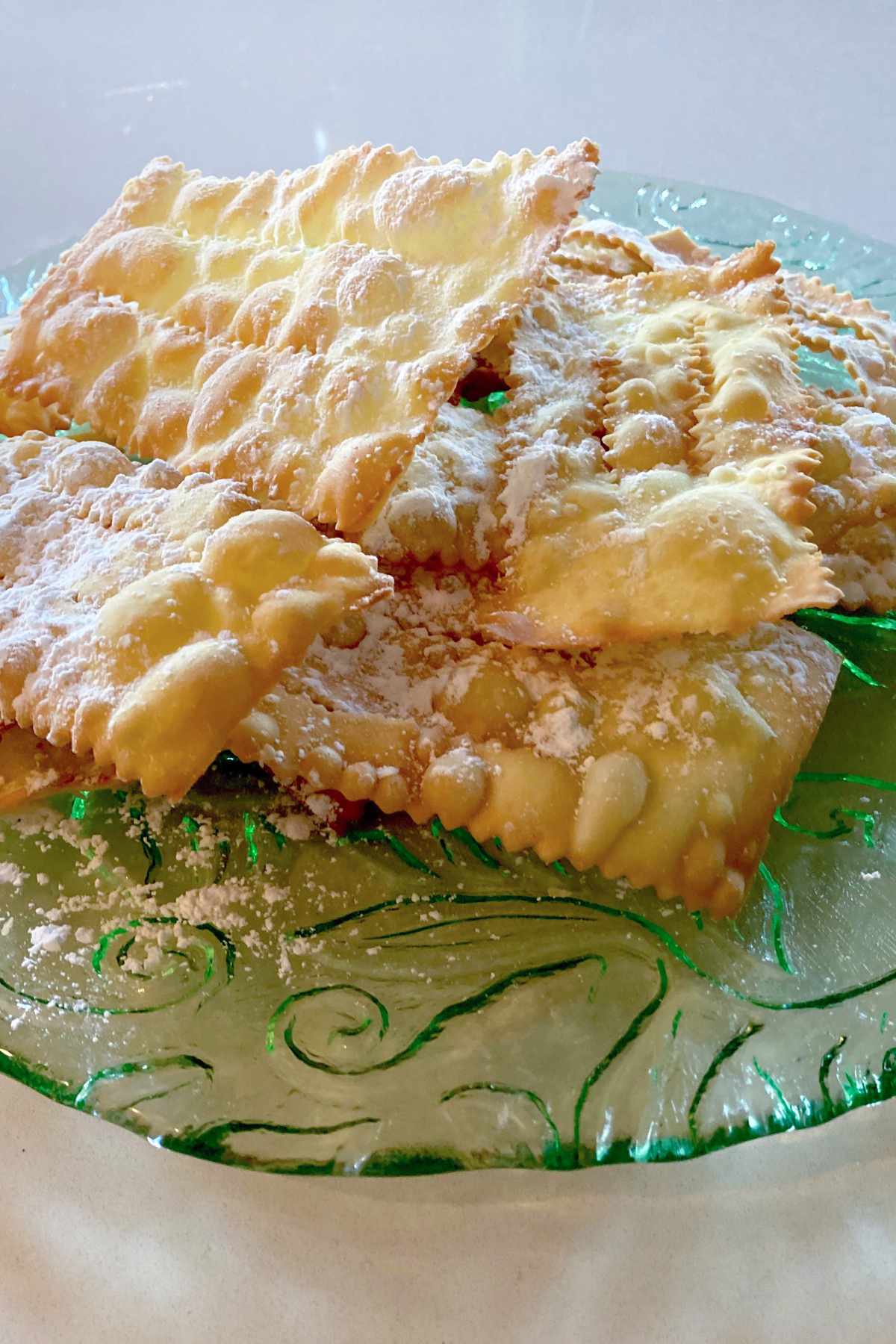
Originating centuries ago, chiacchiere have become a beloved symbol of Italian festivities, particularly leading up to Lent. They are traditionally served alongside other Carnival favorites like castagnole and frittelle.
Each region of Italy has its own slight variation of the recipe, but the essence remains the same: thin strips of dough fried until crisp and adorned with a generous sprinkle of powdered sugar.
For those unfamiliar with the tradition, chiacchiere might remind you of funnel cakes or beignets, but their texture is lighter and airier, making them an irresistible treat.
They pair wonderfully with a cup of espresso, a glass of dessert wine, or even just on their own as a sweet indulgence.
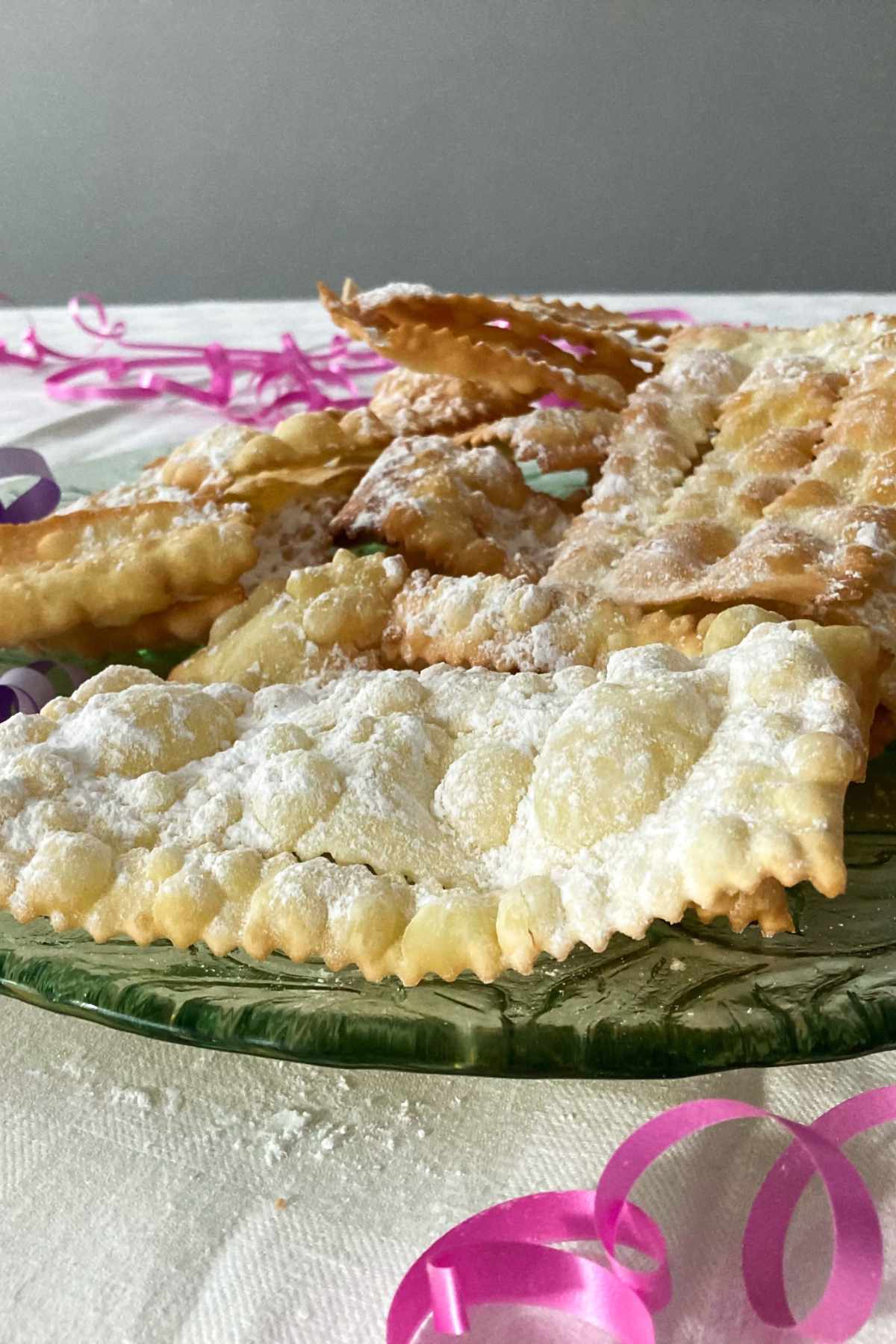
Making chiacchiere at home is surprisingly simple and requires just a handful of basic ingredients: flour, eggs, sugar, butter, and a splash of liqueur for flavor.
The key to achieving their signature crispiness lies in rolling the dough as thinly as possible and frying it at the perfect temperature. The result? A batch of light, flaky cookies that practically melt in your mouth.
And now get ready to impress your family and friends with this authentic chiacchiere recipe!
Jump to:
Ingredients
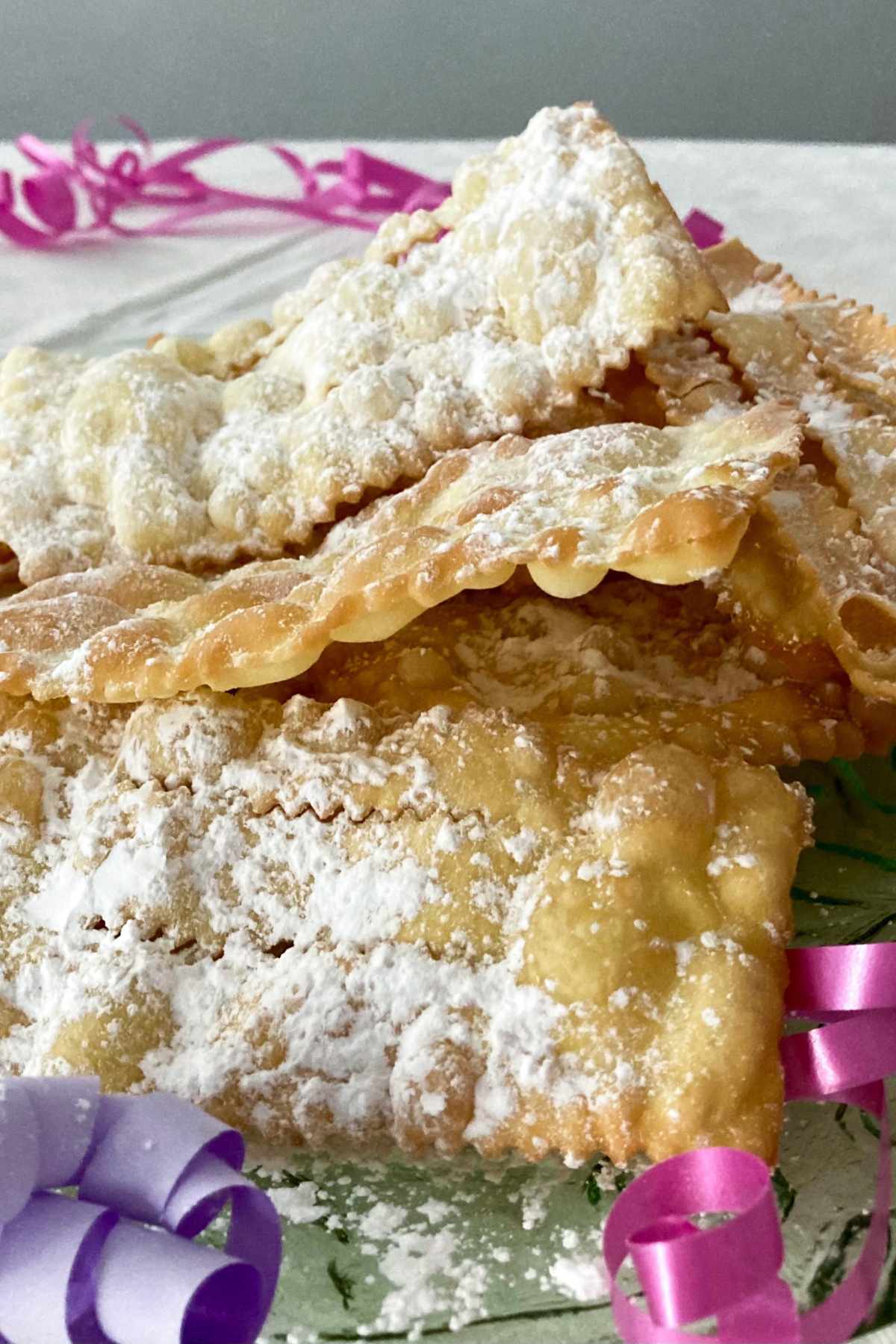
Prep Time: 30 Mins | Resting Time: 30 Mins | Cook Time: 20 Mins | Servings: ~ 8 people - 40 chiacchiere
- 500 g (1.1 pound) flour
- 80 g (6 tablespoons) granulated sugar
- 50 g (~½ stick) unsalted butter, softened at room temperature
- grated zest of ½ lemon
- ½ teaspoon baking powder
- 4 tablespoons Grappa, Passito or Marsala wine
- 3 medium eggs
- 1 medium egg yolk
- ¼ teaspoon vanilla powder
- ¼ teaspoon salt
- 1 liter (4 cups) vegetable oil, for frying
- Powdered sugar, for topping
Kitchen Tools and Equipment
- To prepare the Chiacchiere recipe, a pasta machine is essential for both kneading and rolling out the dough. While our grandmothers skillfully used a rolling pin, a pasta machine ensures the dough is rolled out very thinly (approximately 2mm) and evenly, producing strips of consistent width.
- For cutting the dough, a pastry cutter wheel with a wavy edge is ideal. This tool creates the characteristic zigzag edges that are a hallmark of Chiacchiere.
- A high-edged frying pan is also highly recommended, as it allows you to fry 2 or 3 Chiacchiere at a time with ease.
Instructions
Make the Dough

Step 1) - Start by sifting the flour to remove any lumps. Place the sifted flour, baking powder, and vanilla powder into the bowl of a stand mixer. Attach the paddle (or leaf) accessory to the mixer and run it briefly to combine the dry ingredients. Next, gradually add the sugar, salt, and your choice of liqueur (Grappa, Marsala, or Passito), one at a time, letting the mixer incorporate each before adding the next.

Step 2) - In a separate bowl, beat the whole eggs and the additional yolk together until smooth. Slowly pour the beaten eggs into the mixer bowl while the machine is running. Mix for a few minutes until the dough starts to come together.

Step 3) - Remove the paddle attachment and replace it with the dough hook. Add the softened butter and grated lemon zest to the bowl. Knead the dough on low speed for about 15 minutes. If the dough feels too dry, add a small amount of water (about 10 ml or 2 teaspoons). The finished dough should be firm yet pliable and easy to work with.

Step 4) - Transfer the dough to a clean work surface and shape it into a smooth ball with your hands. Wrap the dough tightly in plastic wrap and let it rest at room temperature for at least 30 minutes. This allows the dough to relax, making it easier to roll out.
Roll Out and Shape

Step 5) - After resting, divide the dough into smaller portions, about 150 g (5 oz) each, to make it easier to handle. Take one portion at a time and flatten it slightly with your palm. Lightly dust the dough with flour, then run it through a pasta roller set to the thickest setting.

Step 6) - Roll the dough several times, folding it in half after each pass, and gradually reduce the thickness setting on the roller. Continue this process until the dough is very thin, about 2 mm (0.08 inch). Lay the rolled-out sheets of dough on a floured work surface and let them rest for a few minutes to dry slightly. Then, using a pastry cutter wheel, cut the dough into rectangles approximately 5x10 cm (2x4 inches).

Step 7) - For the traditional look, make two small cuts in the center of each rectangle.
Frying the Chiacchiere

Step 8) - Heat the vegetable oil in a frying pan. The oil is ready when it reaches 160/170 °C (320/338 F). If you don't have a kitchen thermometer, test the oil by dropping in a small piece of dough. When bubbles form around the dough, the oil is ready for frying. It's very important to be able to maintain the right temperature during frying.
Fry two or three chiacchiere at a time, being careful not to overcrowd the pan. Let them cook for a few seconds on each side until they are light golden and crisp. Use a slotted spoon to remove the fried chiacchiere from the oil, and place them on a plate lined with paper towels to absorb any excess oil.
Once the chiacchiere have cooled completely, sprinkle them generously with powdered sugar. Serve and enjoy this traditional Italian Carnival treat!

YOU MUST ALSO TRY:
- Authentic Italian Tiramisu
- How to Make Italian Cannoli
- Pastiera Napoletana
- Struffoli
- Traditional Italian Sweet Rice Fritters | Frittelle di Riso
- Zeppole di San Giuseppe Recipe
Storage
Chiacchiere are best enjoyed fresh but remain delicious until the next day. To keep them fresh for longer, store them in plastic food bags, being careful not to crush them as they are quite delicate. Properly stored, they can stay fresh for up to 5–6 days.
Variations
- Baked Chiacchiere: A lighter alternative. Prepare as usual, place on parchment-lined baking sheets, spray with water, and bake at 190°C (375°F) for 8–10 minutes until golden. Cool and dust with powdered sugar.
- Vegan Chiacchiere: Egg- and butter-free, made with just 150 g (5 oz) soy or plain yogurt and 220 g (8 oz) flour. Mix into a smooth dough, rest for 30 minutes, roll thin, fry, and sprinkle with powdered sugar.
- Chiacchiere with Dark Chocolate: For chocolate lovers, drizzle melted dark chocolate (200 g / 7 oz) over fried chiacchiere. Let cool until the chocolate hardens.
- Salty Chiacchiere: A savory version perfect with cold cuts and cheese.
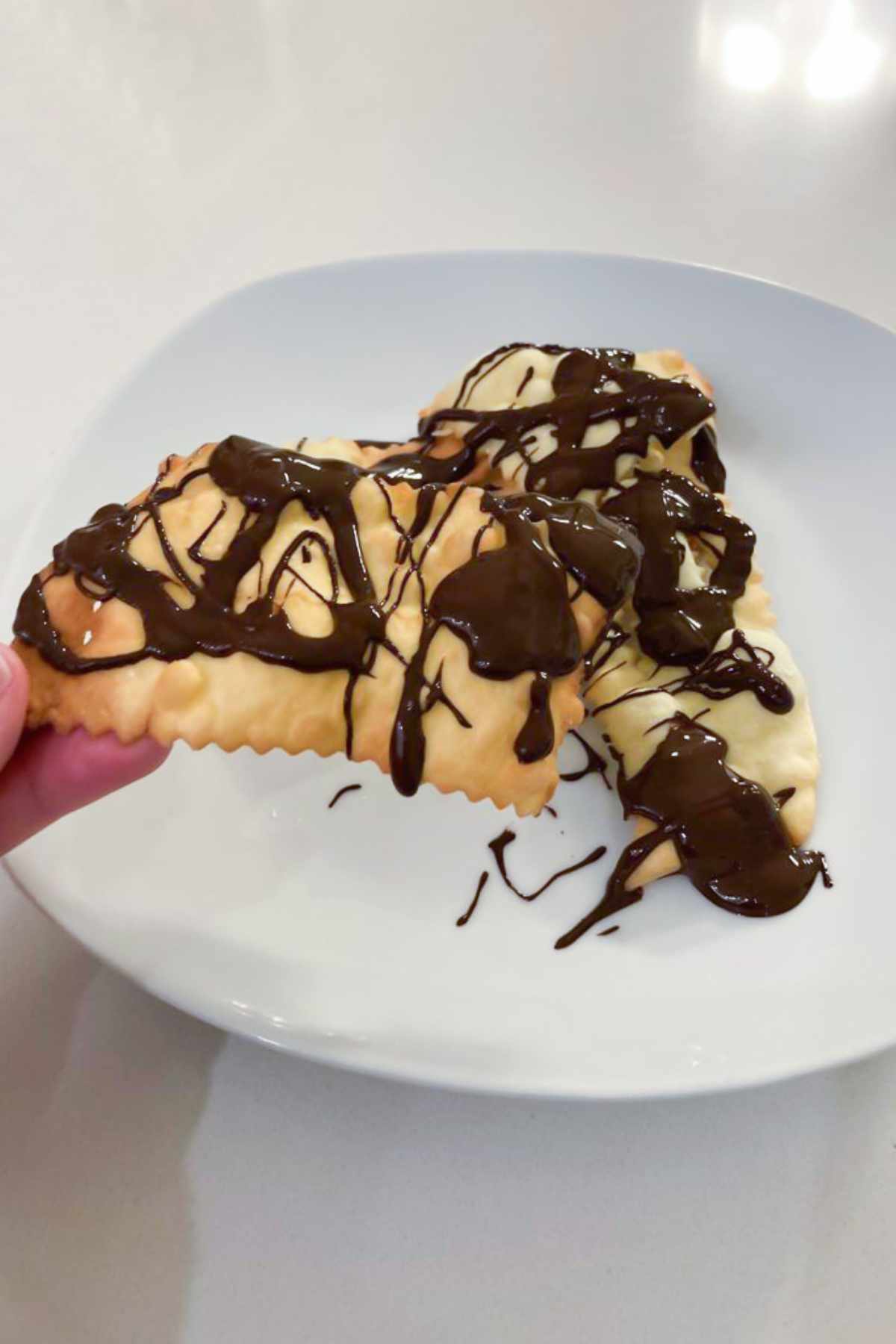
History and Curiosities
The Name and Its Origins
The name Chiacchiere derives from the Italian verb chiacchierare, meaning "to chat" or "to gossip." This term, used primarily in Lombardy and Campania, translates to "chatters" or "gossips."
One interpretation of the name suggests it reflects the lively chatter of women who spent afternoons preparing these fried treats for Carnival while sharing stories and gossip.
Another version attributes the name to Neapolitan chef Raffaele Esposito, who served Chiacchiere at a banquet for the Savoy court. Here, the term "le chiacchiere" alluded to the noblewomen's whispered conversations.
Regional Variations and Historical Roots
Chiacchiere recipes vary across Italian regions. In Northern Italy, the dough is enriched with Grappa and butter, while Southern versions often include olive oil and Marsala.
These treats are also known by different names depending on the region: frappe in Emilia, cenci in Tuscany, bugie in Piedmont, and crostoli in Veneto and Trentino, to name a few.
Their origins trace back to ancient Rome, where a similar pastry, frictilia, was made with flour and eggs, then fried in pork fat.
Frictilia was traditionally served during the Liberalia and Saturnalia festivals, marking the end of winter and honoring the god Saturn.
Although Christianity later tempered Carnival's pagan roots, indulgent foods like Chiacchiere persisted, providing a last festive feast before the abstinence of Lent.

Recipe Card
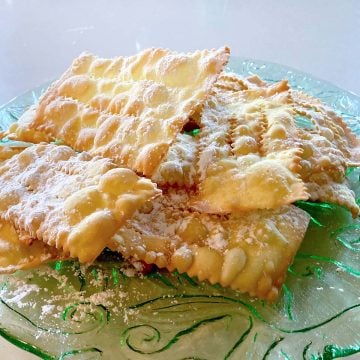
Chiacchiere Recipe (Italian Carnival Fried Cookies)
Ingredients
- 500 g flour - 1.1 pound
- 80 g granulated sugar - 6 tablespoons
- 50 g unsalted butter - ~½ stick, softened at room temperature
- ½ lemon - zest
- ½ teaspoon baking powder
- 4 tablespoons liqueur - Grappa, Passito or Marsala wine
- 3 eggs - medium
- 1 egg yolk - medium
- ¼ teaspoon vanilla powder
- ¼ teaspoon salt
- 1 liter vegetable oil - 4 cups, for frying
- powdered sugar - for topping
Instructions
- Start by sifting the flour to remove any lumps. Place the sifted flour, baking powder, and vanilla powder into the bowl of a stand mixer. Attach the paddle (or leaf) accessory to the mixer and run it briefly to combine the dry ingredients.
- Next, gradually add the sugar, salt, and your choice of liqueur (Grappa, Marsala, or Passito), one at a time, letting the mixer incorporate each before adding the next.
- In a separate bowl, beat the whole eggs and the additional yolk together until smooth. Slowly pour the beaten eggs into the mixer bowl while the machine is running. Mix for a few minutes until the dough starts to come together.
- Remove the paddle attachment and replace it with the dough hook. Add the softened butter and grated lemon zest to the bowl. Knead the dough on low speed for about 15 minutes. If the dough feels too dry, add a small amount of water (about 10 ml or 2 teaspoons). The finished dough should be firm yet pliable and easy to work with.
- Transfer the dough to a clean work surface and shape it into a smooth ball with your hands. Wrap the dough tightly in plastic wrap and let it rest at room temperature for at least 30 minutes. This allows the dough to relax, making it easier to roll out.
- After resting, divide the dough into smaller portions, about 150 g (5 oz) each, to make it easier to handle. Take one portion at a time and flatten it slightly with your palm. Lightly dust the dough with flour, then run it through a pasta roller set to the thickest setting.
- Roll the dough several times, folding it in half after each pass, and gradually reduce the thickness setting on the roller. Continue this process until the dough is very thin, about 2 mm (0.08 inch). Lay the rolled-out sheets of dough on a floured work surface and let them rest for a few minutes to dry slightly. Then, using a pastry cutter wheel, cut the dough into rectangles approximately 5x10 cm (2x4 inches). For the traditional look, make two small cuts in the center of each rectangle.
- Heat the vegetable oil in a frying pan. The oil is ready when it reaches 160/170 °C (320/338 F). If you don't have a kitchen thermometer, test the oil by dropping in a small piece of dough. When bubbles form around the dough, the oil is ready for frying. It's very important to be able to maintain the right temperature during frying.
- Fry two or three chiacchiere at a time, being careful not to overcrowd the pan. Let them cook for a few seconds on each side until they are light golden and crisp. Use a slotted spoon to remove the fried chiacchiere from the oil, and place them on a plate lined with paper towels to absorb any excess oil.
- Once the chiacchiere have cooled completely, sprinkle them generously with powdered sugar. Serve and enjoy this traditional Italian Carnival treat!

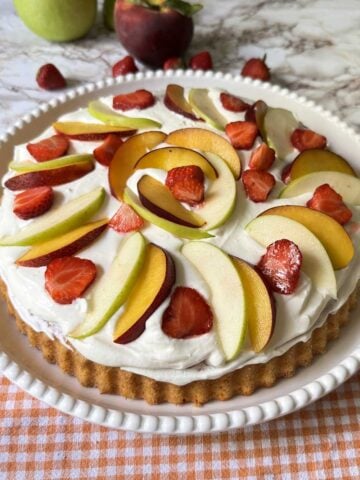



Leave a Reply